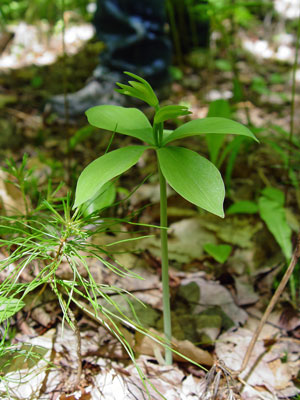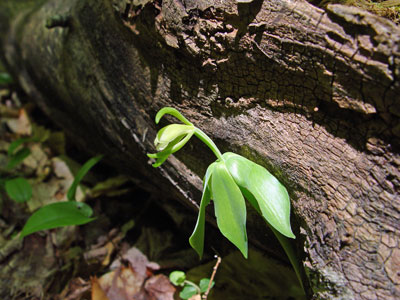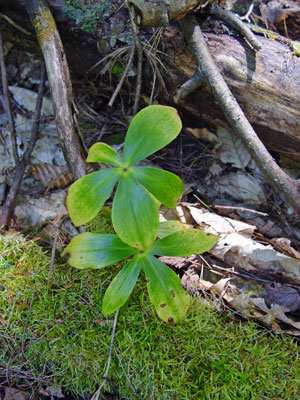DACF Home → Bureaus & Programs → Maine Natural Areas Program → Communities, Plants, and Animals → Rare Plants → Isotria medeoloides

Isotria medeoloides (Pursh) Raf.
Small Whorled Pogonia
- State Rank: S2
- Global Rank: G2G3
- State Status: Endangered
Habitat: Mid-succession mixed forests. [Hardwood to mixed forest (forest, upland)]
Range: New England south to Georgia, west to Illinois, Missouri, and Michigan.

Aids to Identification: A member of the Orchid family, this low herb has elliptical leaves, 3-8 cm long, arranged in in whorls of five. There is one (occasionally two) greenish-yellow flower, about 2 cm long, on a short flowering stalk. The similar Isotria verticillata is distinguished by its longer flowering stalk (greater than 1 cm), taller stem (20-30 cm), and longer sepals (3-5 cm). It is vegetatively similar to the common Indian cucumber-root (Medeola virginiana), but can be distinguished by its pale, fleshy stem, unlike the firm, wiry stem of the common species.
Ecological characteristics: Small whorled pogonia typically occurs in mid-successional mixed woods with sparse shrub and herb layers and thick leaf litter. It often occurs near intermittent streamlets or where a hardpan impedes water percolation into the soil. Associated understory plants include Indian cucumber-root (Medeola virginiana), New York fern (Thelypteris novaboracensis), partridgeberry (Mitchella repens), and rattlesnake plantain (Goodyera pubescens).

Phenology: Flowers in June.
Family: Orchidaceae
Synonyms: Arethusa medeoloides Pursh; Pogonia affinis Austin ex Gray.
Known Distribution in Maine: This rare plant has been documented from a total of 19 town(s) in the following county(ies): Androscoggin, Cumberland, Kennebec, Oxford, York.
Reason(s) for rarity: Unknown; rare throughout its range. This is an extremely rare orchid, often called the rarest orchid in eastern North America.
Conservation considerations: Orchids attract some speciality gardeners, and populations are vulnerable to unscrupulous or uneducated collectors. Plants usually do not survive transplanting, and removing them harms the natural population and may cause its eventual disappearance. This orchid has not been successfully propagated, and any plants offered for sale have been dug from the wild. Populations are vulnerable to conversion of their habitat to residential or commercial use, which is partly responsible for the species' rarity. Partial removal of the canopy may be beneficial, as long as subsequent undergrowth does not overgrow the plants.
For more information on Isotria medeoloides, see the MNAP Rare Plant Publications page for the following:
The Small Whorled Pogonia: A Recovering Endangered Species (Printer Friendly Version-pdf-1.6 MB)